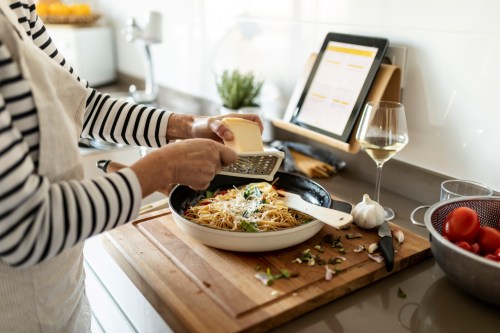Our editors independently select these products. Making a purchase through our links may earn Well+Good a commission
How did everyone get so obsessed with the Instant Pot?
Uh, what is an Instant Pot? Trend experts and industry insiders reveal how the gadget became so popular and if it will reside in the kitchen for good.

As far as kitchen appliances go, the Instant Pot isn’t exactly sexy. It lacks the luxe status of a Vitamix, retro kitsch of a Smeg toaster, or the tricked out tech features of a Samsung fridge. It’s essentially an updated slow cooker, and there are fewer things less sexy than something your grandma uses to make chili.
Yet somehow, the extremely humble IP has become the Meghan Markle of the cooking world: Everyone’s talking about her, everyone wants to be her friend, everyone wants to know her secrets. There are literally hundreds of cookbooks solely devoted to the Instant Pot, with titles like The Instant Pot Bible and Instant Pot Obsession. Hop on Facebook and you can swap recipe ideas with the 1.5 million “potheads” in the Instant Pot Community Group. Or lurk in Alexandria Ocasio-Cortes’ Twitter feed to find hundreds of Instant Pot recipes shared by her fans.
And this isn’t just a niche thing. While Instant Pot’s parent company, Double Insight, keeps its exact sales numbers close to the vest, a company spokesperson told the New York Times in 2017 that sales have more than doubled every year since its launch in 2011. Meaning that lots and lots of people are rapidly jumping on the Instant Pot train.
Of course, there are actually a lot of other pressure cookers on the market—Breville, Cuisnart, and even Crock-Pot have their own models. But just like how people refer to all tissues as Kleenex or all sodas as Coke, the Instant Pot has very quickly dominated the genre in just seven years.
But how exactly did we get so obsessed?
“The target person is anybody.”
If you’re not one of the millions with an Instant Pot in your kitchen and aren’t sure exactly what it even is, here’s a run-down: Basically, it’s an electric pressure cooker, slow cooker, steamer, rice cooker, and yogurt maker, all in one. IP enthusiasts use it to do everything from boil eggs, cook meat, and even make cheesecake.
Yes, it’s a multi-purpose dream, but that’s not its main selling point. “The main reason why people love Instant Pots so much is because it cooks food fast,” says Kara Nielsen, the vice president of trends and marketing at CCD Helmsman. Thanks to the technology of pressure cooking—which uses pressurized steam heat to cook food really quickly without drying it out—you can make pretty much everything that you could in a slow cooker (pot roast, pulled pork, lentil stew) in a fraction of the time.
And while it has many similar functionalities to a traditional slow cooker, the Instant Pot is designed for a very different generation. In the ’70s, the Crock-Pot gave a new class of working women a way to feed their families a home-cooked meal while still being in the office for a full day, according to the Washington Post (because heaven forbid a man should have to touch a dish). That’s similar in some ways to how we live now, where everyone still works (according to the US Department of Labor, 62 percent of families with children have two working parents) and yet still wants something homemade. But the big difference is that no one has time (or the desire) to prep food in the morning to eat after work several hours later.
“Instant Pot is much more suited to today’s rhythms of, ‘It’s four o’clock. What are we doing for dinner?'” —Kara Nielsen, CCD Helmsman
That’s where the Instant Pot’s speed comes in play. For example, making chili from start to finish takes about an hour total in the Instant Pot, depending on your recipe. In a slow cooker, however, you’re looking at over six hours of cooking time for most recipes. It’s hard to argue with that math, especially in an increasingly stressed, strapped-for-time society.
“After years of slow cookers and rice cookers, that lifestyle of the home cook that puts a chicken or a pork stew on in the morning, and then goes to work all day and comes home to a dinner, is a different lifestyle,” says Nielsen. “People don’t live that way now…Instant Pot is much more suited to today’s rhythms of, ‘Oh my gosh. It’s four o’clock. What are we doing for dinner?'”
And that’s the exact need Instant Pot is hoping to serve. “The target person is anybody who has a busy lifestyle—young professionals, professionals, busy moms, busy parents, busy dads, or college students.” says Anna Di Megilio, Instant Pot’s marketing manager.
Consider it a healthy life-hack that’s actually worth a damn
The Instant Pot also rose to dominance at the same time that people started to get more interested in healthy eating. Sales of organic food in the U.S. totaled nearly $50 billion in 2017, alternative eating plans like Paleo, keto, and vegan diets are quickly becoming more mainstream, and millennials in particular are even willing to pay more for foods they think are healthy (like gluten-free or sustainably-sourced). While people in the past may have been more willing to microwave a TV dinner or order takeout when the post-work hunger pangs struck, customers now are more conscious of what’s in their food, and cooking things yourself gives you total control over ingredients, portion size, and nutrition.
But honestly, it’s exhausting to DIY healthy foods. Do you know how long it takes to strip kale, chop it, and massage it before you can even eat it? Have you ever tried to peel a butternut squash by yourself? And the whole meal-prepping thing can be a major time-suck.
Which leads into the other key to Instant Pot’s success: FOMO. “We also live in this time of viral craziness and ‘life hack’ culture,” Nielsen says. “People always want to know the latest hack.”

Instant Pot has played on that love of insider-y hacks from the beginning. According to the New York Times, the Canadian company initially sent 200 devices to key food influencers (chefs and food bloggers alike) in order to jumpstart their American sales. Reviews started coming out online, people began posting recipes, and boom—a star was born.
Healthy eaters really took to the Instant Pot from the get-go, particularly vegetarians and Paleo dieters—likely because pressure cooking makes preparing staples like large cuts of meat, beans, or legumes much faster than with traditional cooking methods. And people are largely still using their Instant Pot for those two types of foods, says New York Times food writer and Dinner In An Instant author Melissa Clark. Yet people have also found ways to use the IP for every kind of diet, as proven by the vast quantity of IP-specific diet cookbooks: The Keto Instant Pot Cookbook, The Ultimate Vegan Cookbook for Your Instant Pot, The Whole 30 Slow Cooker (which comes with lots of IP recipes too, don’t worry), The Gluten-Free Instant Pot Cookbook… Following a healthier eating plan, no matter how niche, is suddenly a lot more accessible when you have something that makes preparing your everyday staples much faster.
“It’s got all of these things going for it: being a hack, being tech, having gone viral in the sense that there’s this urgency around when to get it on Amazon Prime Day and other big deal days,” says Nielsen. “People hear about it and are like, ‘What’s this Instant Pot thing that I’m missing out on?'”
What is it good for? Almost everything
Unlike detox teas (which, don’t do those), that Instant Pot FOMO isn’t just hype. Just read any of the 23,000 5-star reviews for the Instant Pot Duo (the best-selling model on Amazon) and you’ll see that people legitimately love this thing. “How did I live without this before???” raved one reviewer. “This thing is a real game changer!” wrote another. It’s also consistently given top marks by the Good Housekeeping Institute, Consumer Reports, and Wirecutter for its performance and affordability compared to other pressure cookers on the market.
Of course, it’s not perfect. Even the biggest fans are quick to acknowledge that the device comes with a steep learning curve to sort out the different buttons and settings. The “cook time” in recipes doesn’t always factor in the extra time it can take to bring the Instant Pot up to temperature and to depressurize it when you’re done cooking, which means you might be spending an unexpected extra half hour or so in the kitchen. And while the IP is innovative, certain foods are just not meant to be cooked in a steam environment (like fried tofu or anything that you want to be well-seared or crispy).
“People hear about it and are like, ‘What’s this Instant Pot thing that I’m missing out on?'” —Kara Nielsen, CCD Helmsman
But even the Instant Pot’s downsides can be advantages if you know what you’re doing, says The Fresh and Healthy Instant Pot Cookbook author Megan Gilmore. “It has a tendency to overcook vegetables,” she says, which she used to think was a bad thing…until she learned about the “zero minute” cooking cycle (which steams the vegetable while the device is coming up to temperature and then is immediately removed). “People see that in my book and think it must be a typo, but that’s an actual setting on the Instant Pot.” Translation: you can spend even less time cooking veggies if you know how to do it right.
While people may be excited to buy specific IP cookbooks for their eating habits right now, Clark predicts there will be less of these in the future as the device becomes as standard in the kitchen as a food processor or stand mixer. “I remember when my parents got the first Cuisinart when I was a little girl and it came with a cookbook because people didn’t know how to use it,” she says. “Now, it’s a regular kitchen tool.”
Meanwhile, Instant Pot is constantly continuing to evolve the product to keep customers happy—and to keep people talking. “We have new models coming out every 18 months,” Di Meglilio says. Hey, if there’s one (ahem) hack everyone knows, it’s that you have to feed the beast.
Go crazy with your Instant Pot and try out this recipe for apple cider vinegar-braised chicken. And here’s how to clean it, which is a bit tricker than it sounds.










